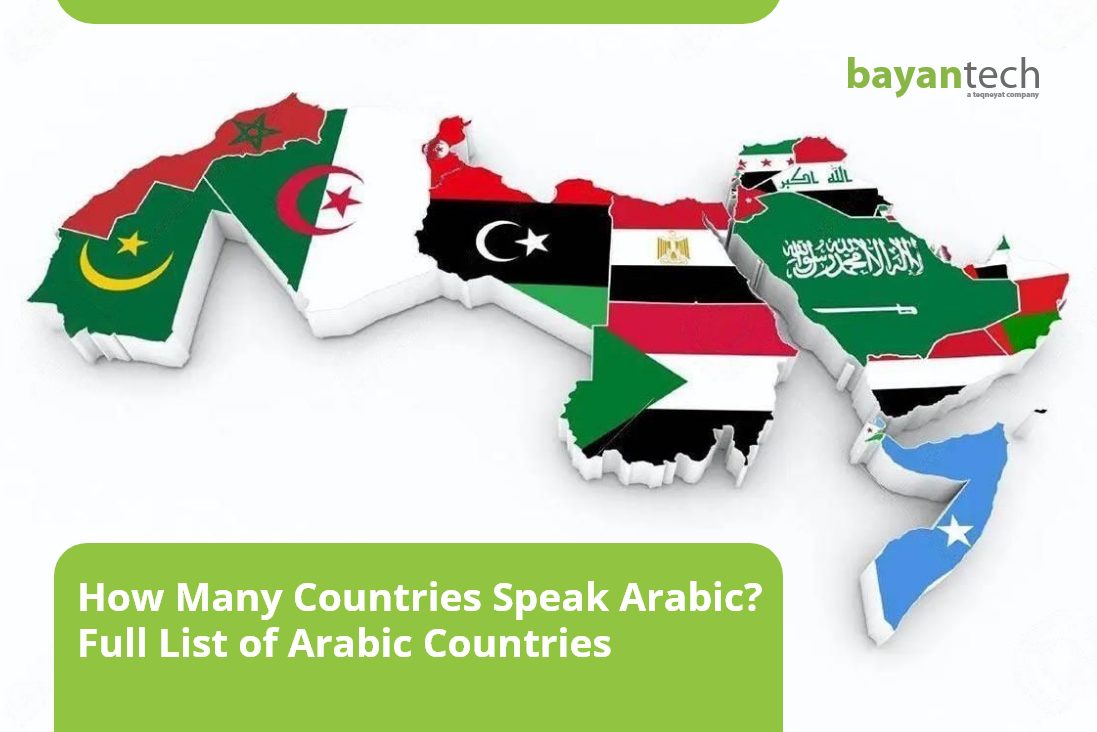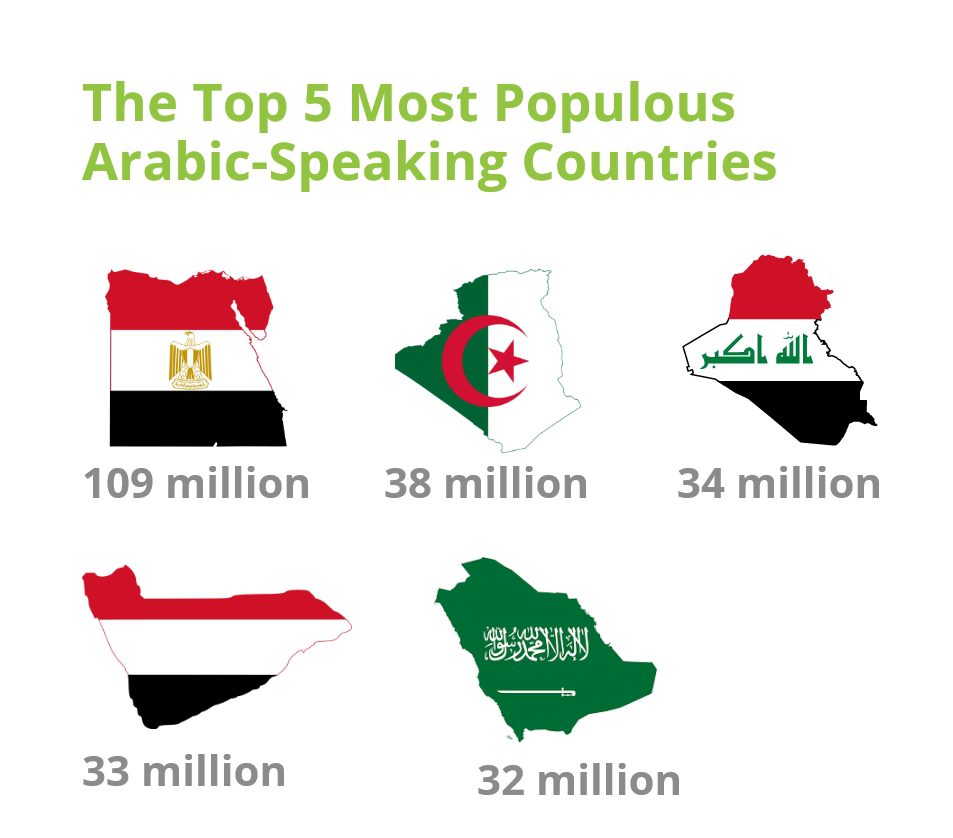Did you know that words like coffee, cotton, candy, and alcohol, among many others you use daily, are borrowed from the Arabic language? It’s fascinating to think about how much influence Arabic has on our everyday vocabulary!
Arabic is one of the most popular languages in the world. However, you might be surprised to learn just how many countries speak Arabic as their native tongue and the incredible linguistic diversity that exists within the Arabic speaking world.
From the bustling streets of Cairo to the ancient city of Damascus, Arabic has a rich history that spans centuries and has evolved into numerous regional variations, each with its own unique characteristics. These variations reflect the diverse cultural fabric and nuances that shape each population’s identity.
So, without further ado, let’s take you on a journey through the Arabic-speaking countries, exploring the history of the Arabic language and how it has developed into the many dialects we hear today!
Which Countries Speak Arabic?
Arabic is the main official national language in 22 countries in the Middle East and North Africa: Bahrain, Iraq, Jordan, Kuwait, Lebanon, Oman, Palestine, Qatar, Saudi Arabia, Syria, United Arab Emirates, Yemen, Algeria, Chad, Egypt, Libya, Morocco, Sudan, Tunisia, Mauritania, Comoros, and Djibouti.
Beyond the Arab world, Arabic also holds a significant presence in various countries such as Turkey, Iran, and parts of Central Asia. These regions are home to Arabic-speaking communities due to the historical ties and geographical proximity they share with the Arabian Peninsula.
How Many People Speak Arabic Worldwide?
Arabic is one of the most widely spoken languages in the world, with an estimated 373 million people speaking it as their first language. This makes Arabic the fourth most spoken native language worldwide.
Egypt is one of the major countries that speak Arabic and is home to the largest number of Arabic speakers with more than 109 million native speakers. Other countries that speak Arabic with significant populations include Algeria, Yemen, Iraq, and Saudi Arabia, each with more than 32 million Arabic speakers.
In addition to the countries that speak Arabic as their native tongue, Arabic is also learned as a second language by millions of people worldwide. This is particularly true for Muslims, as Arabic is the language of the Qurʾān (the holy book of Islam), and understanding Arabic is essential for reading the Quran and performing religious rituals. As a result, many non-Arab Muslim countries, such as Indonesia, Pakistan, and Nigeria, have fairly large populations of Arabic learners and speakers.
The Historical Spread of Arabic
The Arabic language, a member of the Semitic family within the Afro-Asiatic language group, has a rich history of expansion and influence. Its spread was driven by a combination of religious expansion, trade, cultural exchange, and linguistic influence. So, let’s explore the historical journey of the Arabic language and its development.
The spread of Arabic is closely tied to the rise of Islam in the 7th century AD. As the Islamic faith expanded through conquest and trade, the Arabic language gained prominence as the language of religion, administration, and commerce. The Quran was revealed in Arabic, further solidifying the language’s importance within the Islamic world.
The adoption of Arabic by various communities across the Middle East and North Africa as well as parts of Europe and Asia was a gradual process. As Islam spread, Arabic became the lingua franca of the Islamic empire, and the main tongue for communication and cultural exchange.
Over time, as Arabic spread across vast territories, it evolved into various dialects and regional variations. These dialects reflect the diverse cultural and linguistic influences in different parts of the Islamic world. So, let’s break down the linguistic diversity of the Arabic language!
The Diverse Dialects of Arabic Speaking Countries
Classical Arabic
Classical Arabic, the language of the Quran and pre-Islamic literature, flourished between the 7th and 9th centuries. Though it’s no longer a spoken language in everyday life, its influence remains deeply embedded in modern-day Arabic. You can typically find it used in religious texts, classical literature, and academic studies of Arabic language and literature.
Modern Standard Arabic (MSA)
MSA, the official language of most countries that speak Arabic, is a direct descendant of Classical Arabic. While it has evolved over time to reflect modern contexts, its grammar and vocabulary share similarities with the classical form of Arabic. Today, Arab countries use Modern Standards Arabic in education, government, media, official documents, and any formal communication.
Regional Arabic Dialects
There are around 30 major Arabic dialects, with several sub-dialects and local variations. While all regional dialects share a common root in Modern Standard Arabic and Classical Arabic, they have unique characteristics and may vary in vocabulary, pronunciation, and grammar.
We can categorize the numerous varieties of Arabic into 5 main groups:
- Egyptian Arabic is spoken in Egypt and widely understood across the Arab speaking world due to the influence of Egyptian media.
- Levantine Arabic is used in Syria, Lebanon, Jordan, and Palestine.
- Gulf Arabic is prevalent in Saudi Arabia, UAE, Kuwait, and Qatar.
- Maghrebi Arabic is Spoken in North Africa, including Morocco, Algeria, Tunisia, and Libya.
- Iraqi Arabic is used in Iraq and has influences from Persian and Turkish.
bayantech: Your Gateway to Cross-Cultural Communication
Located in the heart of the MENa region, bayantech is a leading provider of Arabic translation services in addition to +185 other languages including all African and major Asian and European languages. We help organizations overcome cultural and language barriers throughout their journey in foreign markets through professional translation.
Get in touch today and learn how our solutions can streamline your international communication and drive your business forward!
8 Steps Every Medical Interpreter Takes
Looking for a medical interpreter? Discover the career path of medical interpreters and qualifications they need to acquire to take on interpreting jobs.











